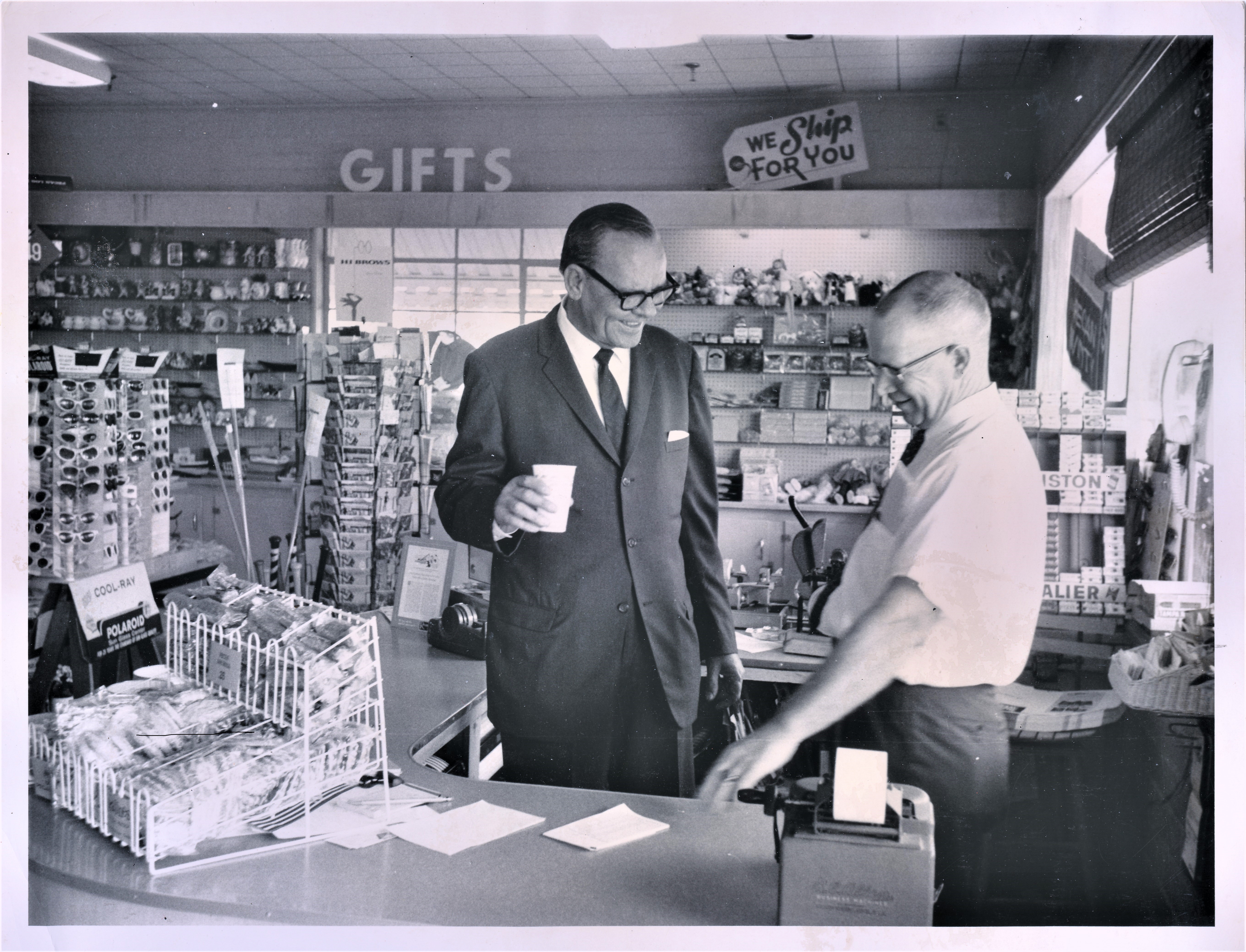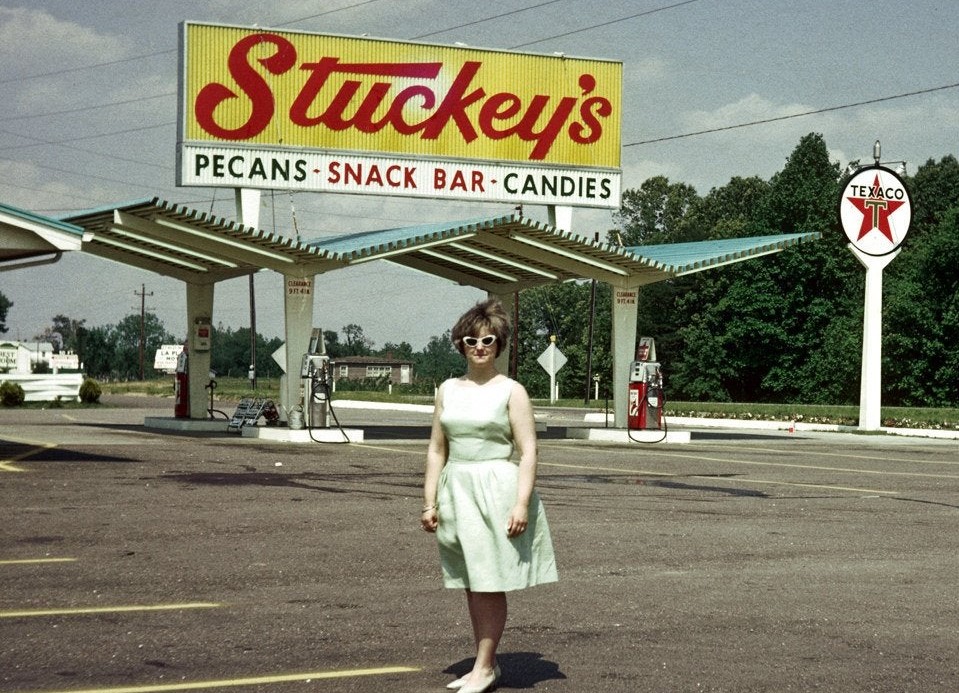Then, it slipped from the hands of the Stuckey family into a steep decline. Now, it’s fast regaining its reputation. Stephanie Stuckey has been at the helm of the iconic company since 2019, and she sees reviving the great American road trip, whether a Sunday afternoon drive or a two-week vacation, as one of her guiding principles.
“It’s also celebrating the pecan. The two really go hand-in-hand because we started as a pecan stand on the side of the road,” Stephanie said. “So, we’re trying to embrace the history of the road trip. We became our most popular when the road trip peaked — that’s when we hit our high point. With the road trip coming back, which is pretty exciting, we are coming back. Everybody loves a comeback.”
The Father of Stuckey’s
In the newly incorporated city of Eastman, Georgia, Williamson Sylvester Stuckey was born in 1909 to William Ira and Sallie Lee Williamson Stuckey. A little more than two decades and one depression later, Sylvester, by then a law school dropout, was making one cent per pound buying pecans from local farmers around the Middle Georgia countryside and reselling them to a local sheller named Fred Bennett. Despite the Great Depression throughout the U.S. and Florida’s own depression brought on by two giant hurricanes in the late ‘20s, American tourists — granted, in smaller numbers — were still traveling to Florida in the 1930s. And Eastman was right on the path to and from the Sunshine State.
And so, with a borrowed truck and $35 cash loaned from his grandmother, Sylvester opened a humble roadside stand to sell packages of pecans to Florida tourists. To further eke out a living, he convinced his wife, Ethel Mullis Stuckey, to make candies from some of 1937’s plentiful pecan crop. Ethel put those pecans to use and learned to make pralines, divinities, and the soon-to-become-iconic log rolls. The first “official” — that is, in an actual building — Stuckey’s roadside candy and gift shop plus gas station opened that year in Eastman on U.S. Highway 23. A candy production plant was soon built behind the gift shop to keep up with demand. The second Stuckey’s location opened in the late 1930s at Unadilla, Georgia, on U.S. 41. The next Stuckey’s that opened was in Florida, in a location just south of the Georgia/Florida border at Hilliard on U.S. Highway 1. More locations followed in the 1940s.

“Because of World War II and so many people sending candy to soldiers in the war, a lot of candy was produced,” explained Gary Yawn, retired insurance, real estate, and timberland entrepreneur; personal friend of Sylvester Stuckey; and Eastman local historian. “These young men came back from World War II, it was like an education to a young person, because when they got back, they got jobs, they started traveling, and the Stuckey’s stores were a big hit. Those stores were a big part of their success, so Stuckey was able to expand his industry and expand his candy manufacturing, and sometimes people would buy an interest in a store back then.”
A Roadside Empire
By the early ‘50s, a double-page magazine ad listed 16 locations, mostly in Georgia and Florida, but also in Tennessee, South Carolina, and Virginia. Profits were expected to go up further from a deal struck in 1950 with Texaco, who was to be their exclusive gasoline supplier. A new corporate headquarters and candy factory opened in 1953 in Eastman. Those first 16 locations seemed to multiply like rabbits throughout the decade of the 1950s, making the Stuckey’s roadside stop synonymous with clean restrooms, tasty candy, a good variety of snacks and souvenirs, gasoline, and anything else a motorist could possibly need. The iconic teal-blue peaked roof attracted the traveler’s attention and the Texaco flag waved them in, where they were assured of a clean, safe, and fun break from the road. For those who didn’t travel or who lived in a rural area nowhere near a brick-and-mortar Stuckey’s, catalogs offered candy, treats, and souvenirs by mail order.
“People were somewhat ‘country,’ even the northerners, you were just not as educated and not as traveled [until after World War II,] especially in the South,” Yawn added. “Now, I’m proud of the South, my granddaddy was a state legislator. [But] they came from that time and date, all common people, and Stuckey captured that. Stuckey went to the University of Georgia and he was a well-traveled guy.”
The story is told that Sylvester cleverly began to calculate how far apart Stuckey’s locations should be by driving the highways himself and taking note of how long a cup of coffee would last or how soon a restroom might be needed. He was said to favor locating a Stuckey’s store on the east side of the highway so it would be on the motorists’ right-hand side as they headed back home from Florida.
By its 1960s peak, Stuckey’s had simply become an integral part of the classic American road trip, including along the new interstate highways. Sometimes, that’s all there was at an interstate exit — just that highly recognizable teal-blue roof signifying the consistency that was Stuckey’s. There were 368 stores in more than 30 states, radiating outward from the Eastman, Georgia, home base. Billboards in yellow and red along the highways advertised the nearest Stuckey’s location and often a current special, like “two eggs, toast and jelly, for 99 cents.”
Support businesses kept the roadside empire running smoothly. Stuckey’s candy plant in Eastman still produced the famous sweet treats. They owned a trucking company to ensure that products were delivered promptly to the stores. And their own sign company produced the 4,000 yellow-and-red billboards that dotted America’s highways.
In 1964, Stuckey’s made a merger decision that seemed to make sense at the time — to add capacity and capital — but would carry fatal consequences just 13 years later. The Pet Milk Company, in its growth from producer of canned evaporated milk to multi-brand food products conglomerate, purchased and merged with Stuckey’s. Sylvester, however, now 55 years old, kept a hand in running the company and served on the company’s Board of Directors.
Decline of an Icon
1977 was a sad year for Stuckey’s, the company, and Stuckeys, the family. On January 6, at the age of 67, Sylvester Stuckey died. Later that year, the Chicago conglomerate known as Illinois Central Industries (ICI) purchased Pet Milk Company. Although ICI grew out of the Illinois Central Railroad in 1962, it had been created as a holding company to diversify at a time when the railroads’ investment returns were not good. Their diversifications included real estate, industrial products, financial services, and consumer products, including Pet Milk Company, with its ownership of Stuckey’s. ICI, as owner of Pet Milk Company and its subsidiaries, began to close Stuckey’s stores across the country, and in the late 1970s, the legendary roadside stop began its decline, leaving just a handful of stores open.
Billy Stuckey’s Revival
But entrepreneur W.S. “Sylvester” Stuckey had left behind a namesake who also became a force to be reckoned with. Williamson Sylvester Jr., known as “Billy,” held a Bachelor of Business Administration completed in 1956 and an undergraduate law degree achieved in 1959, both from the University of Georgia. Billy had been a five-time Democratic U.S. Representative from the Peach State from 1967 to 1977. And, whether or not he knew it at the time, he had the perfect vehicle for turning Stuckey’s around — once he got the company back, that is. Billy had built up a massive business opening Dairy Queens along the American interstates. His Interstate Brands Dairy Queen company owned hundreds of the popular red-roofed soft-serve shops across the 48 contiguous continental states. Billy astutely realized that — and deftly took advantage of — interstate highway travel had become, by the early 1980s, a vital fact of life.
Meanwhile, back at ICI, the company that owned Stuckey’s was in litigation. “My dad was running multiple businesses; he was a serial entrepreneur. His main business was not Stuckey’s,” explained Billy’s daughter, Stephanie. “Then, he bought back [Stuckey’s] from the company [that owned it] that was facing litigation from franchisees for the way the company was being managed. My dad was able to negotiate that if the company were to be given back to the Stuckey family, they would drop the lawsuit, so the benefit was from my dad getting [Stuckey’s] back for basically nothing, and [ICI] was getting this huge litigation mess off of their hands.
So, in 1984, Stuckey’s was back in the hands of, well, the Stuckeys, and the iconic roadside chain began its turnaround under Billy’s experienced leadership. Launching the Stuckey’s Express concept put “a store within a store,” a move which soon expanded to 165+ franchises in 17 states. “Nowadays, there’s a TA or Subway or Wendy’s, there’s whatever, [along the highway.] That wasn’t the case in the 1980s, so he [Billy] was really a pioneer in co-branding, just like my grandfather was with the original roadside retail,” Stephanie added. “So, I had a lot to learn from them. Really, my father figured out how to pivot and change the business model to make Stuckey’s work, given where the company was when he acquired it.”

But, the Great Recession in 2007-2009 took away discretionary income from many families across the country, and travel services and attractions suffered from it. The candy plant in Eastman, operated by a third-party contractor, closed, and outside vendors began to produce Stuckey’s brand candies. At that point, Stuckey’s was just a decade away from another generational hand-off. “When my dad got it, he made Stuckey’s work by incorporating it into what he was doing [Interstate Brands Dairy
The Third Generation’s Turn
W.S. “Billy” Stuckey Jr. retired in 2019, and his daughter Ethel (named for grandmother Ethel Stuckey) “Stephanie” Stuckey was up at bat if she wanted to be. And she wanted to be.
“[When] I became the CEO, nobody else wanted to do it. I would have happily stayed, I mean, I had a career working with the sustainability of buildings. It was interesting work and I was getting paid a nice salary. I had a life,” Stephanie said. She also had a Bachelor of Arts and a law degree from the University of Georgia, had worked as a trial lawyer, had been politically active since her teens, and had — savvy in the ways of political campaigns by then — won her own successful bid for the Georgia State House of Representatives. For a decade, she had worked on environmental issues as director of sustainability services for Southface Institute, an Atlanta-based organization, but the appeal of saving the iconic family business (again) won out.
“My dad sold his Dairy Queens over a decade ago to Warren Buffett and then he and his business partners at Stuckey’s all kind of shut down shop and left Stuckey’s with a skeleton crew. That’s how I got involved. They hadn’t had any leadership for over a decade and my dad’s former business partners were looking to sell their shares. I said, ‘Well, if I’m going to buy the company, I’m going to run it,’ because nobody was. It was literally on autopilot with two employees and a skeleton crew — five employees — in the warehouse and three sales reps, and [we] rented all this space. It had been like that for decades and just losing money, and nobody knew what to do with it. I said, ‘I’ll buy it,’ so that’s how it happened. I bought out my dad’s partners and then I bought out my dad in June of 2020. I bought out his shares because he’s retired and I said, ‘Just let me run the company, Dad, just relax,’ because he was freaking out over all that had to be done. ‘You don’t have to do any of this.’”
Since Stephanie took over as CEO, Stuckey’s has acquired Front Porch Pecans, Atwell Pecans, The Orchards Gourmet, and Thames corporations, which added distribution, candy making, pecan processing, and fundraising expertise and opportunities to the company. With the Front Porch Pecans merger, Stuckey’s also acquired manager and Georgia pecan grower R.G. Lamar, who became the new company president.
And what would grandfather Sylvester have to say now? “I wish I knew. I was 12 when he died, and I think about him all the time. I spent my first three-to-four months on the job reading through articles written about him to get an understanding of how he ran the company. I tried to be true to his spirit of entrepreneurship. I like to say that Stuckey’s is an 80-year-old startup. I really do think like a startup, because that’s what we are doing, we are re-imagining the company. In many ways, I’m going back to how we were when we started in 1937, the roadside stand when we were selling pecans. We’re back to selling pecans, we’re back to shelling pecans, we’re back to making our own candy. I’m doing some of the things he did, but what I’m running now is not the same company that he sold in 1964. I think he would also get a real kick out of knowing that I bought this candy plant in Wrens, Georgia, right across from an old Stuckey’s store, and the plant I bought was run by a man named Atwell of Atwell Pecans. My grandfather did business with Mr. Atwell, so I think he would like it.”
The Rebound
Grandfather Sylvester would most definitely like it. There are now 65 franchised locations, and a distribution center in Stuckey’s hometown of Eastman, Georgia. A pecan processing and candy plant produces their own Stuckey’s branded products. An online business picks up where the mail-order catalogs once left off, and about 200 retailers sell Stuckey’s pecan snacks and candies. A branding refresh this year will make things look new again with the traditional 1940s logos. And the new logo says it all — “We make road trips fun.” There’s a lot to like.

The word about Stuckey’s return to roadside glory is getting around. Business journals and major newspapers have published feature stories. Tim Hollis, author of numerous books about Southeastern US media and attractions, combed through collectors’ memorabilia plus various company archives to write and publish a book in 2017 entitled simply Stuckey’s. In an era of road trip revival, when the past is honored and kitsch is cool, Stuckey’s fits right into the mix.
A Plaque Marks the Site
The first Stuckey’s gift shop building still stands on U.S. Highway 23 — Oak Street — right across the road from the tidy-looking mom-and-pop Eastman Motel. It’s currently empty, time-worn, and vintage-shabby, although the original candy plant and other buildings behind it have housed warehouse space and local businesses. Out in front stands an impressive plaque commemorating Mr. and Mrs. W. S. Stuckey and their establishment of the legendary Stuckey’s. One could look at this old building with its faded blue roof and easily see it as symbolic of the Stuckey’s decline during the late 20th century.
But the thing is, it’s also a significant reminder of the amazing success that Sylvester Stuckey built during the Mid-Century from such modest beginnings. Just think of all those family station wagons up and down America’s highways that pulled up to an iconic Stuckey’s roadside location, to get gas, select souvenirs and sweets, and maybe have breakfast or a sandwich. The familiar teal roof and the Texaco flag flying out front signaled the first and the best in terms of travel services. But now, in many locations across the US, the modern tourist can once again stop at a travel store and find Stuckey’s products. An iconic Pecan Log Roll, just like Ethel used to make. Maybe a rubber alligator or the Red Drinking Bird for Aunt Betty. Certainly, a bag of Georgia pecans for snacking during the next leg of the trip. And, just like the Stuckey’s mail-order catalog of yesteryear, fans can now order goodies online. You can still get your own piece of America’s national treasure — Stuckey’s. It’s there waiting for you, where the romance of the road and the needs of everyday life collide in the classic American road trip.
